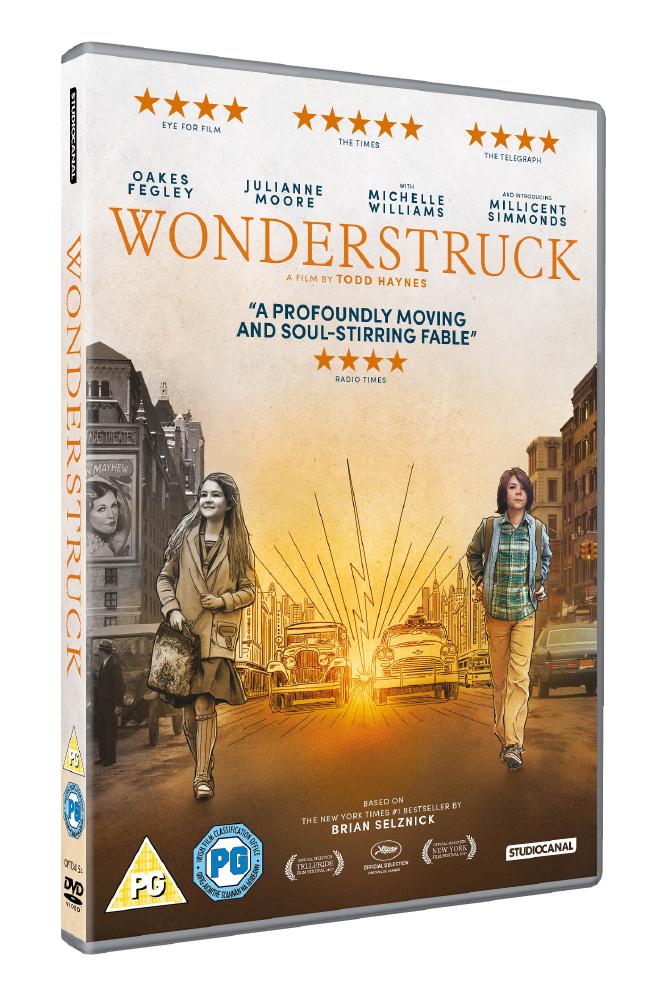After a long search to find the young actress who would play a crucial role in Wonderstruck Todd Haynes says that when he first saw Millicent Simmonds’ audition tape he knew that the journey was finally over - he’d found his girl.

The Oscar nominated director was determined that, if possible, a deaf girl would play the part of young Rose. “I thought that not only would she bring a depth of experience to it and a personal specificity to that role but it would be something that we would all benefit from, we would all have access to this experience and this person and learn more about this culture,” he says.
“So it was my first choice and if we didn’t find somebody who could fulfil that job we would move on and go to hearing actors and there would be a much larger pool to draw from obviously.
“But when I saw Millie’s first audition tape there was a spark, a kind of self-possession, in this kid that was so clear and so strong it really brought tears to my eyes when I first saw it.
“And then you kind of cross your fingers and think ‘I hope this holds up in all the stages that we go through.’ and it did. So that was really the discovery of the film.”
Wonderstruck, based on the children’s novel by Brian Selznick who adapted his own book for the screen, is the story of two deaf children separated by five decades.
Thirteen year Millie, making her screen debut, plays the young Rose who runs away from her domineering father to New York to try and find the silent movie star, Lillian Mayhew (Julianne Moore) she idolises in the 1920s section of the film, which is shot in black and white and features no dialogue.
In the 1970s section of the story, Oakes Fegley (Pete’s Dragon) is Ben who heads to New York after the death of his mother (played by Michelle Williams) to try and find the father he has never known. Haynes describes the film as a “mystery” about two children trying to find themselves. Both stories eventually connect.
“Wonderstruck is an incredibly unique story of two children navigating their way through Manhattan 50 years apart,” says Haynes. “Both of them are deaf – in one case, with Ben, he is newly deaf – and they are trying to figure out who they are and where they came from. And the film takes you on their journey and answers those questions as they discover themselves.
All ages will connect with Selznick’s moving story about finding a family, he feels, and younger audiences will identify with Rose and Ben and the obstacles they face.
“I think that there is something about limited abilities that kids innately understand. I saw The Miracle Worker when I was a kid and there was something about the story of Helen Keller and the story of language, a specific language that belongs to the disability of deafness – and that distinguishes that disability from any other because it has its own language – that was so fascinating to me and I think spoke to something that I already knew about the ways in which we all navigate the world with limitations.

“And kids get that. And I think there is something really poignant about the fact that both of these kids are doing that in these two very different moments in history. It’s something that we all carry within us in our lives and our own histories.”
For Haynes, filming a story set in two time periods was a welcome opportunity to pay homage to the films of those eras – the silent movies of the 1920s and American cinema of the 1970s, a golden period in the medium.
“Because they each come with such an incredibly rich cinematic legacy, these two eras, in that regard there was such a wealth of material. Particularly from the 1920s, which was one of the high points of our cinematic history
“It was humbling, almost overwhelming, to look at films even just from 1927 and 1928. Some films I’d never seen before, like The Crowd, which I’d read about but never seen before and it’s very hard to find that movie.
“It’s an incredibly inspiring piece of work by King Vidor. And with the 1970s is one of the richest periods in American filmmaking and for urban, New York based content it was great. What was tricky was that we had to shoot a bit of both eras each day. That was a challenge.”
Wonderstruck is the director’s fourth collaboration with Ms Moore, who plays two roles in the film – the silent movie star Lillian Mayhew in the 1920s and older Rose in the 1970s. They had previously worked together on Safe, Far From Heaven and I’m Not There. He describes the Oscar winning actress as a creative “soul mate.”
“Working with Julianne has been an amazing through line of my professional life and creative career,” he says. “We were a lot younger when we did Safe but I was stunned by the sense that I found a soul mate who understood this almost unimaginable character on the page of the script and brought a dimension to it that I was still vaguely feeling out.
“She brought a clarity to that role and made it work conceptually. She brought specificity to it, a meaning to it that made the film richer. It’s been a privilege in my life to continue to work with Julianne.
“I keep going back to her and throwing her very different challenges each time. And this is our fourth film together. I remember when we were making I’m Not There when she played this hysterical sort of homage to (singer) Joan Baez that cracked me up so much that I had to leave the room because I was laughing so much that I would have ruined the take. But it’s an amazing thing to find a partner like Julianne.”
Haynes was born and raised in California and produced his first film, The Suicide, whilst still at High School. He made his first film as a director, Assassins: A Film Concerning Rimbaud, when he was studying at Brown University.
His other films include Velvet Goldmine, Far From Heaven, I’m Not There and Carol. His acclaimed HBO series Mildred Pierce, starring Kate Winslet, Guy Pearce and Evan Rachel Wood, won 12 Primetime Emmy awards. He was nominated for an Academy Award (Best Original Screenplay) for Far From Heaven.

Wonderstruck will be available to own from July 30, 2018.

